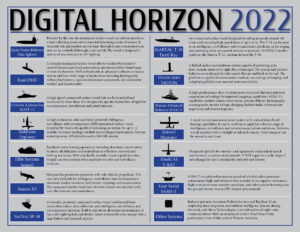The U.S. 5th Fleet has started a three-week long unmanned and artificial intelligence integration event in the Middle East, dubbed Digital Horizon, with 15 unmanned systems and 17 industry partners.
The event began on Nov. 23 and is based in Bahrain. The Navy boasted it will employ several new platforms in the region for the first time.

“I am excited about the direction we are headed. By harnessing these new unmanned technologies and combining them with artificial intelligence, we will enhance regional maritime security and strengthen deterrence. This benefits everybody,” Vice Adm. Brad Cooper, commander of U.S. Naval Forces Central Command, U.S. 5th Fleet and Combined Maritime Forces, said in a statement.
This is part of the fleet’s effort to quicken integration of unmanned technology in the area of operation via Task Force 59. Cooper previously said he is seeking to have 100 unmanned surface vessels (USVs) operating in the region by the summer of 2023 integrated into a mesh network. 20 percent of the USVs are due to be U.S. vehicles. (Defense Daily, Oct. 14).
A Digital Horizons exercise previously occurred in December 2021. The Navy said this time it will include 17 industry partners with 15 different types of unmanned systems. Ten of the unmanned systems will operate with the 5th Fleet for the first time in Digital Horizons.
Participating unmanned aerial vehicles include the Aerovel Flexrotor Group 2 small tactical UAS with vertical take-off and landing (VTOL), the Shield AI V-BAT, which is also a VTOL, and the Easy Aerial tethered UAV.
USVs include the Elbit Systems Seagull, Exail DriX designed for underwater mapping, L3Harris Technologies’ [LHX] Arabian Fox MAST-13 designed for U.K. testing, Marine Advanced Robotics’ Wave Adaptive Modular Vessel (WAM-V), MARTAC’s T-38 Devil Ray, Ocean Aero’s TRITON autonomous underwater and surface vehicle, Open Ocean Robotics’ Data Xplorer solar-powered USV, a Saildrone Explorer, a Seasats’ X3 10-foot long micro autonomous surface vessel (ASV) and SeaTrac’s SP-48 multi-purpose solar-powered ASV.
The Navy said other industrial partners Accenture Federal Services and Big Bear AI will use data integration and artificial intelligence systems, while Silvus Technologies will provide line-of-sight radio communications and an Ocius USV participates from off the coast of Western Australia during the event.

“The pace of innovation is amazing. We are challenging our industry partners in one of the most difficult operational environments, and they are responding with enhanced capability, fast. I am extremely proud of the entire team, including our many partners across government, academia, and industry for their commitment to Digital Horizon, as we discover new capability together,” Capt. Michael Brasseur, commander of Task Force 59, said in a statement.
The Navy noted Task Force 59 operated USVs for over 25,000 hours in the last year, equating it to 12 years of nine-to-five testing five days a week. The Saildrone Explorer has specifically operated at sea for up to 220 consecutive days without maintenance or refueling.
This comes after L3Harris last month said it made an almost $10 million minority investment in the Seasats, which has nine full-time employees and some contractors (Defense Daily, Oct. 19).